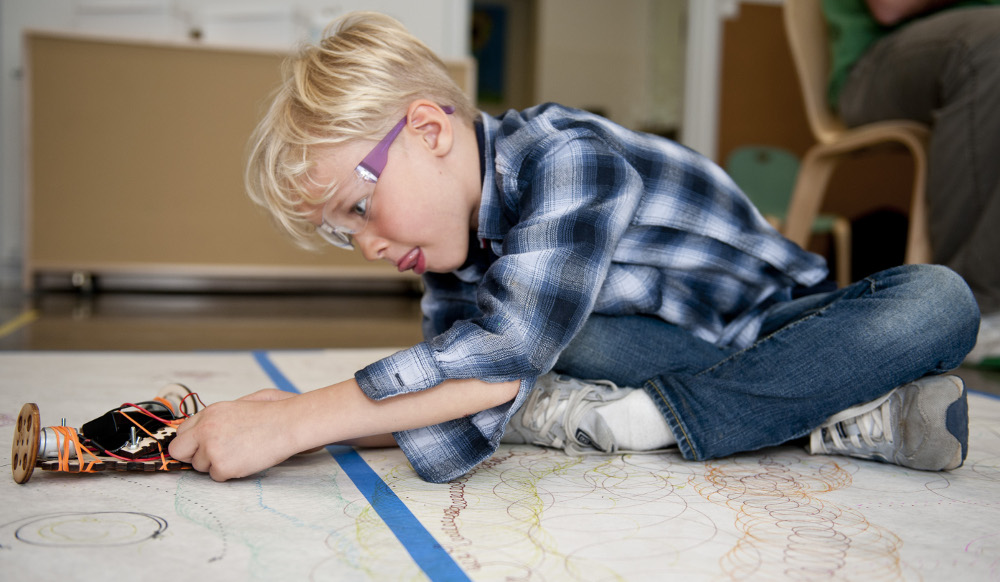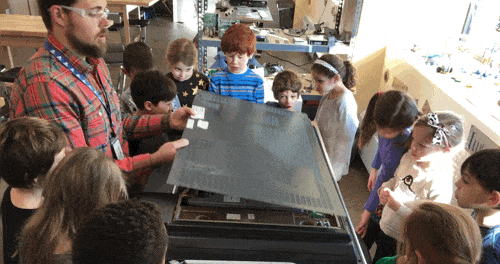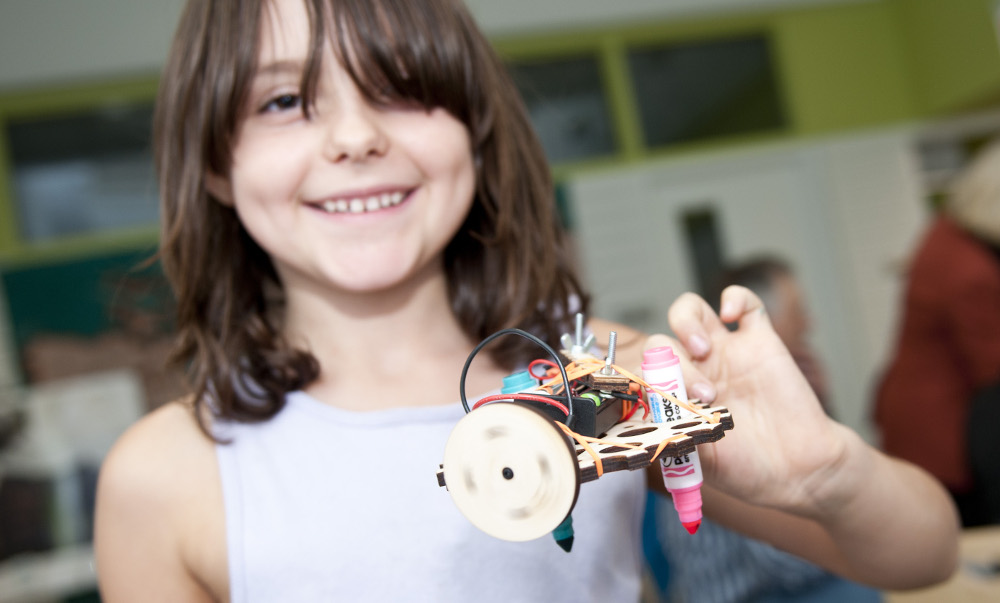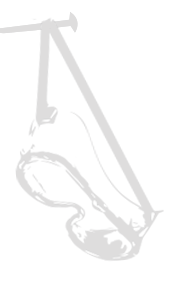


Bennett Day School is an independent school located in downtown Chicago. Founded in 2014, the school’s mission is to provide a collaborative culture that nurtures children’s innate sense of inquiry and curiosity.
“What got me so excited was that look on a kid’s face when they do something for the first time.”
—Colin Reynolds
Colin Reynolds is Senior Kindergarten Teacher and TinkerLab Curator at Bennett Day School. Bennett Day is an amazing new school, and we admire the way Colin has integrated Tinkering into the student experience there. Do you know an Educator in Action who we should meet? Email us at tinkering@tinkeringlabs.com.
A student inventor in the Bennett Day School TinkerLab.
Colin, thanks for being our second Educator in Action! Can you start by sharing your journey to becoming an educator? What led you to make education such a big part of your life?
Colin:
I guess my journey has been lifelong. I’ve always been involved with children. I was a babysitter as a kid, I coached sports when I was in high school, and when I played baseball in college we also ran camps for kids. My college advisor suggested that I take education classes, so I did. I had to pick a major when I was a junior, and I had more Education credits than anything else, so I picked it! Right after graduating I got a job as a first grade teacher. And at that moment when the classroom door closed behind me and there were 19 children in front of me, I just fell in love with the children and the excitement and the energy that they brought.
What kind of school did you start in?
Colin:
It was a very traditional public school in the western suburbs of Chicago in a pretty affluent neighborhood. After a few years in first grade I moved to fourth grade, which I loved even more because the kids were more independent. All along, I was also coaching a high school baseball team. So I got the younger kids during the school day and then after school I was with the teenagers. I got to see the whole spectrum and really enjoyed just sharing knowledge and seeing kids learn and apply things they learned.
I think what got me so excited to continue was seeing that look on a kid’s face when they do or truly understand something for the first time: you know they’ve been trying to figure it out and the excitement and the energy that comes from is hard to beat. I got my Master’s in Educational Leadership at Loyola University in Chicago and then became an administrator. I was an assistant principal and tried to work with all the teachers to teach the way I was teaching, which was very project-focused, and very different from what most of the teachers in our school were doing. They were using standard curricula – day one, day two, week one, week two – all the way through testing, at the end giving grades. That didn’t come naturally to me. What came naturally to me was exploring the questions and issues that the kids brought to school and both following and guiding them on that journey.
“What came naturally to me was exploring the questions that kids brought to school and following and guiding them on that journey.”
So when I moved into administration I got the chance to work with teachers to do those kinds of things. And an interesting thing happened – my school and district kind of slid me more toward our gifted and talented program and our accelerated math programs and accelerated this, and accelerated that, so that I could continue to do that kind of stuff because that’s how they thought: “Well, you know this is only for gifted kids; this is for advanced kids.” I knew in my heart of hearts that that was for everybody. We just had to find a way to make it accessible and scaffold content and resources to the age levels and ability levels of the kids we were working with.
That is really interesting. I think that’s a really good point. Approaches that are sometimes reserved for the “gifted and talented” could be great for everyone in so many cases.
Colin:
I think one of the experiences that really changed my whole mindset about which kids it was for was an after school Minecraft club that I started. There were a couple of kids who were sort of quiet in the classroom, and teachers thought they weren’t inspired or not interested but they were really bright kids. I found out they loved Minecraft and I said “Hey, you guys want to start a club after school?” Their eyes lit up and they were like, “Yeah!” So it started with me and two 5th graders just playing Minecraft after school.
And you know, it slowly evolved into eight kids, a dozen kids, and then parents asking all kinds of questions but loving it. And the administration was also asking some questions and not really knowing how to think about it. But teachers saw that these kids—I don’t want to say they were outcasts, but they were very quiet, and usually sort of on the fringes of whatever was happening. These kids were right at the center of this club that was so exciting and creating so much energy in the school.
Colin Reynolds introduces students to the guts of a TV at the Bennett Day School TinkerLab. Wow!
That is so cool.
Colin:
So to connect that with where I am now… I got a teaching award pretty early in my career from the Golden Apple organization in Chicago. They get nominees and then they hand out awards for exceptional teachers. I got this award and it was super inspiring and encouraged me to keep doing what I was doing. It was through Golden Apple that I learned about a new school and when I read through the description I couldn’t believe it, because I was like “This is exactly how I teach. I want to be a part of a school that does this institutionally.”
That came to be Bennett Day School. I was very persistent in following up. I kept volunteering. Eventually they hired me and on the day the school opened I was our Senior Kindergarten Teacher and TinkerLab Curator.
EDUCATOR IN ACTION TIPS
from Colin Reynolds, Bennett Day School
- Play with it first. As simple as that sounds, it will help you with your students.
- Don’t plan too much. Start by introducing the parts and watching the kids work. Then have a brief reflection, asking: “Hey what did you notice? What questions do you have? How do you think we might use these materials the next time?”
- Adapt it for your community and students. Every community is different. Think about what kinds of challenges will engage your kids.
And the rest is history! You’ve clearly decided to do a lot of hands-on and open-ended learning with your students. How do you bring it into a school environment like the ones you have worked in?
Colin:
I think hands-on learning is so important because it puts the individual who’s got their hands on the stuff in the driver’s seat. The student is in control whether it’s math with manipulatives or language where teachers are starting to use letters that you can move and slide to make words and build sentences. But when it comes to open-ended learning, where you’re not sure what the outcomes might be, that is challenging. Teachers like to have an end goal and open-ended learning sort of throws that goal to the side and says, “Yeah. I hope that’s what we learn, but we might learn other things along the way too.”
That fear of the unknown can be very overwhelming. Actually I just ran into this with an activity I did this afternoon with some first graders. I thought it was a very clear cut activity that was going to introduce problem solving skills, but ten minutes into the lesson we’re taking a right turn. And that’s OK, it doesn’t have to end up right where I want it to end up. I just have to find a way to adapt to what the kids are doing.
But I think any lesson that is open-ended can be very nerve wracking. For example Kane’s arcade is a very popular video that inspires people to let children work with cardboard, but what’s going to become of a teacher in a room with 20 kids and a stack of cardboard? Nobody really knows. And so how do you guide them? How do you make sure that learning goals are being met? It takes time to plan those lessons, introduce skills and follow up with individual kids to make sure they’re getting what you want them to get.
The pure joy of invention.
What was the project you did today, that you thought was heading one way and ended up being something different?
Colin:
It was with our first graders and we were using Legos. The game is called Block and Cover, and Lego has it in one of the curriculum books. The kids are supposed to play the blocks in a certain way, and count the studs at the top of the Lego blocks. The kid with more studs showing is the winner.
Well you can about imagine how many different ways kids want to stack blocks. They want to try this, and try that, and so many things the kids were trying are not outlined in the curriculum.
So they are asking, “Can we do this? If I put my block like that is it OK?” The manual doesn’t say yes or no. So I’m going to say yes! I understand where they’re coming from, and they are showing the creativity that teachers talk about wanting to have. This is the innovation that you want to see in the classroom, coming from listening to a child. You can take a child’s idea and say, “You know I didn’t think about it that way but you did that and that’s OK and that’s great.” Suddenly we’re not just playing the game and learning math, we’re inventing a new game and learning math.
And that’s really interesting. We talk a lot about the power of trusting kids with their own ideas.
Colin:
Well. I just want to comment briefly on that, the idea of trust with students, whether they’re three-year-olds or they’re 17 years old. A three-year-old may say something that sounds wild but it’s authentic, it’s meaningful to them and the fact that they’re saying it is enough for a teacher to…should be enough for teachers, to believe that maybe there’s some validity there. “Maybe I can trust you as a three-year-old that your perception of the world, however silly it may seem to an adult, is really your idea and there’s something to work with there.” You can trust them the way you want the students to trust you, the teacher.
Right, very interesting. How are you using the Electric Motors Catalyst with your kids and do you have any tips for other teachers?
Colin:
I think kids, or really all people, love seeing that things have switches, that light up, make sounds, move, and do all this sort of non-human type activity. I took advantage of that at a science camp, as a director of Camp Invention, for a few summers.
One of our activities was a “Take Apart” where fourth and fifth graders would bring in a big electronic item and we took the whole thing apart. So a room of 25 kids wearing safety goggles, using screwdrivers and hammers would pull and bang apart every piece that’s on an old computer. Seeing all the stuff that’s in there was just so fascinating.
So when I was planning our TinkerLab, that’s where I wanted to start… let’s take something apart. The kids were asking all these questions: “Why are there lines here? What do those circles mean?” These are six-year-olds asking very basic questions about things they recognize, which got me thinking about circuits and like, “OK, well those are circuits and how do we talk about the flow of electricity and how can they understand that anything that is electronic or has electricity and has circuits, and wires, and stuff behind it?” So when I found the Tinkering Labs Catalyst kit, I just thought it was a tremendous tool. You can use it to show what is behind all electronics, which is a power source, wires, and the flow of electricity from the source through some kind of component. Kids can do it themselves. “Hey! Here’s the energy, connect it here, connect it there, and make something happen!”
“When I found the Tinkering Labs Catalyst Kit, I just thought it was a tremendous tool.”
That’s enough to get them curious about why that happens, and then we can talk about the flow of electricity. The Catalyst kit made that very accessible, because it breaks down the idea of a circuit to a very changeable and usable set of materials. The way the wood pieces are cut and all the different nuts and bolts and everything that comes with the kit from the rubber bands to the markers are all exciting to the kids. I am doing this with five- to eight-year-olds, and it’s all recognizable and engaging to them, so I can only imagine…like those challenge cards are perfect for 10, 11, 12 year olds to understand how to get a motor standing and make something happen, but now let them make something useful. I don’t know how useful an eggbeater is…
Eggbeaters are useful!
Colin:
Right! But that concept is powerful, that the kid can be challenged to do something with electricity and apply it in a novel way to create something useful. They could just go to a store and buy an eggbeater and come home and just use it, but when they’ve actually made it to solve a problem, they now have this heightened level of understanding and a more useful knowledge base for problem solving and understanding the world around them.
That’s a great description. We always hope when kids have that experience, and they do see an eggbeater in real life, or a car, or motorcycle, or anything that does something similar to what they were able to do with the catalyst, that they have that awareness. We hope they’ll think, “Wow, some other group of people went through the same process I just did and figured out how to make this work, and here it is! And maybe there is a better way that I could think of.”
Colin:
That’s a good point actually. A kid makes something that beats an egg, but is there a better way? Can we beat more eggs, or do it faster, or with less splashing? Just having something to build off so we can go through a process of design and iteration, that all the kids can understand, sort of levels the playing field for everybody and builds greater understanding.
Wonderful. Do you have any tips for teachers who are starting with the Catalyst? If someone’s going to bring it into their classroom for the first time, is there anything you would suggest that they do?
Colin:
I would definitely say, “Play with it first.” And I think that, as simple as it sounds, as an adult, looking at something that’s supposed to be made for children…There’s nothing wrong with you kind of putting pride aside and saying, “I’m going to play with this, understand it. I’m going to learn it. I’m going to ask one of my colleagues to come in and do it with me.” Maybe you could do it after school at your house, just play with it and make something, no matter how meaningless it might seem to you, but it helps you build a sense of what children might do. Play around with it first, get comfortable with some basics.
Then that first day, I wouldn’t plan too much other than just introducing the parts and watching the kids work with them and then have a brief reflection and discussion at the end of it to say, “Hey, what did you notice? What questions do you have? How do you think we might use these materials the next time?”
Those three questions can be really helpful following an open-ended sort of play experience. At Bennett Day, we do that with any new material I put out on the table. That first day, that first experience, is very unstructured, open-ended, just use it. Play with it and see what happens and then have a breakdown. Kids have questions they want to understand. At play, they constantly raise their hands, calling the teachers name. “Well, what about this. Why does this happen? How do we do this? Can we do that?” These are all great questions that we want to answer and the kids want answers to. But when the kids are asking the questions versus the teachers asking, it makes a world of difference in the mind of the children.
Thank you, that’s great. Tell us a bit about Bennett Day. What are your goals with your students? And how do you think it’s different from other educational opportunities in Chicago?
Colin:
The short one-liner is that Bennett Day is a school that “advances creativity and innovation,” and that’s at the core of everything we do. We talk a lot about nurturing children’s innate sense of curiosity. We want great citizens, we want human beings who know how to take their knowledge, take their skills, and apply them to make our world a better place. We want them leading. We want them leading in whatever field they go into, whether they’re an engineer, or a doctor, or an artist, or performing artist—any field they go into. And I think that’s sort of the thing we try to keep in mind from day one, is that this idea of advancing children to become lifelong learners and leaders in our world is really what drives us.
OK. Well thank you so much for that. Is there anything that you want to add?
Colin:
The only thing I would add is that what we are doing at Bennett Day School can be done anywhere, but in ways that make sense for that location. Here in Chicago we are in the heart of an urban environment. I know it’s the same for you out in San Francisco. We both have tremendous resources all around us.
I grew up in northern Minnesota, very small town, very rural farm country all around, but there were tremendous resources there, too. And the schools in those places reflect the communities that they’re in. No one school should try to take what’s done in Chicago or San Francisco and just pick it up and drop it into their school and try to do it exactly the same way, but I think they should take ideas and concepts and materials like the Catalyst kit—it’s not just a plug for the kit—it’s a really great set of materials that can be put into a school and then sort of adapted to what that community values, and turned into something that’s meaningful for the people that are in that space.
And I think that’s really at the heart of what makes any school great. It’s the people there and the way that they use the resources and the materials at their disposal to create things that are meaningful. And when that happens, when a community constructs a school experience together, it’s more powerful than any one set of curriculum. It’s the community and the creative use of the environment that they’re in that makes it magic.




